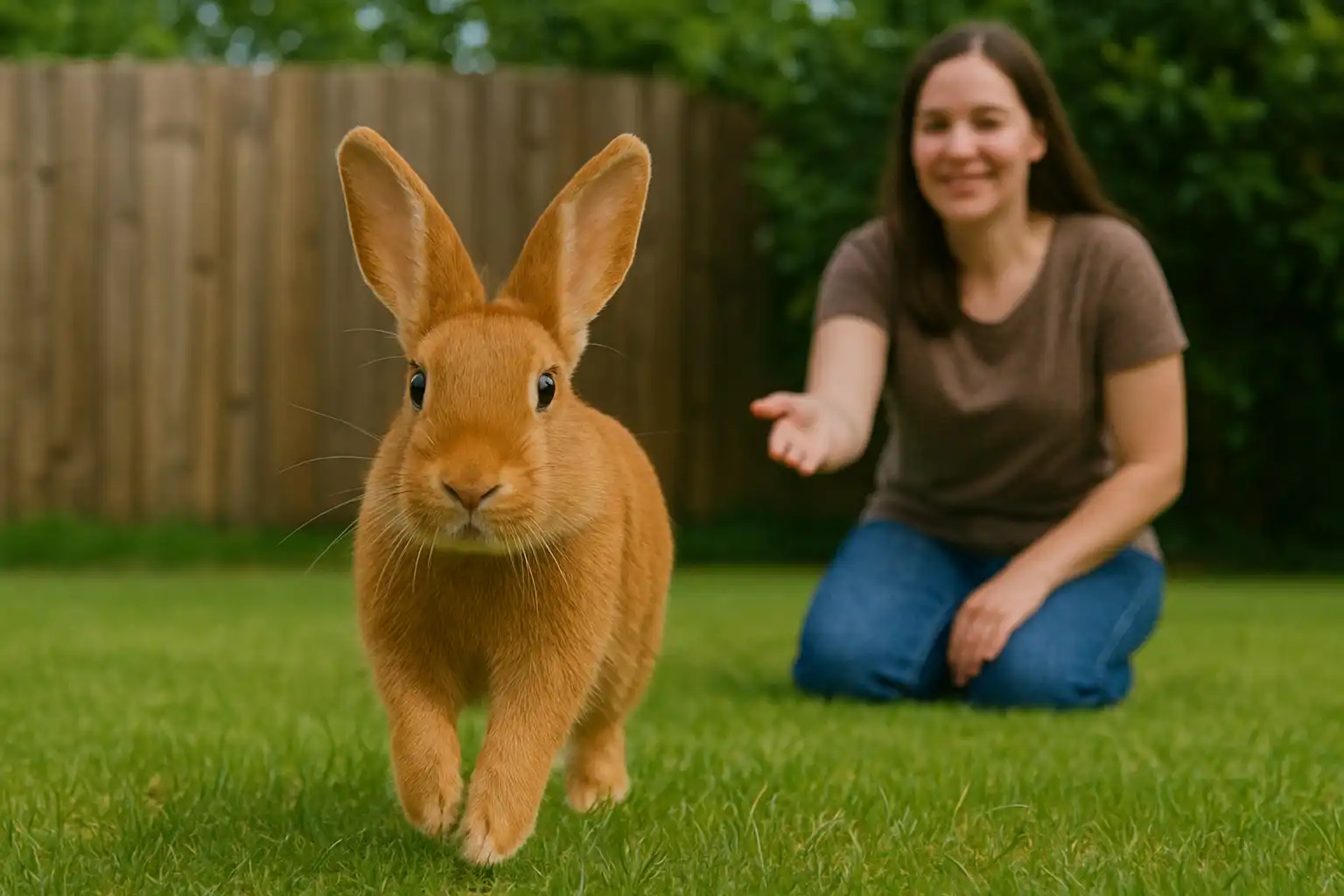Learning how to train your bunny to come when called creates a stronger bond between you and your rabbit while providing essential safety in emergencies. This comprehensive guide shares proven techniques and troubleshooting tips from experienced rabbit owners.
The first time my rabbit Clover actually hopped to me when I called her name, I nearly dropped the treat I was holding out of pure shock. After weeks of patient training, that moment of connection felt like magic. How to train your bunny to come when called isn’t just about teaching a cute trick—it’s a practical skill that strengthens your bond and could potentially save your rabbit’s life in an emergency situation. Whether you’re a new bunny parent or looking to teach an old rabbit new tricks, this comprehensive guide will walk you through the process of training your bunny to respond reliably when called.
How to Train Your Bunny to Come When Called: Understanding Bunny Behavior
Before diving into training techniques, it’s crucial to understand how rabbits think and respond to stimuli. This foundation will make the process of how to train your bunny to come when called much more effective.
Importance of Training in Bunny Behavior
Rabbits are naturally curious and intelligent animals, capable of learning a variety of commands and behaviors. Learning how to train your bunny to come when called taps into their natural instincts while providing mental stimulation. In the wild, rabbits communicate through body language and sounds, and domestic bunnies retain these instincts. When you train your bunny to come when called, you’re essentially creating a positive association with your voice and presence. This is also the foundation of how to bond with your bunny in a meaningful way.
I’ve found that trained rabbits tend to be more confident and less stressed overall. My rabbit Clover was initially very skittish, but after consistent training to come when called, she became noticeably more relaxed around the house. This type of training reinforces that you’re a source of safety rather than a potential threat.
Common Bunny Responses to Commands
When first beginning how to train your bunny to come when called, you might notice various responses. Some rabbits may immediately perk up their ears and hop toward you, while others might look confused or even hop in the opposite direction. This variation is completely normal and depends on your bunny’s personality and previous experiences.
Most rabbits will display these common responses during training:
- Ear movement (forward-facing ears indicate interest)
- Nose twitching (processing the sound and associated smells)
- Brief freezing (processing the command)
- Head tilting (curiosity about the sound)
- Slow approach (testing whether it’s safe to respond)
Understanding these responses helps you gauge your bunny’s comfort level with training. When I first started training Clover to come when called, she would freeze momentarily before cautiously approaching—a normal response that gradually evolved into an enthusiastic hop as she learned to trust the process.
Factors Influencing Bunny Training
Several factors can impact how quickly your bunny learns to come when called:
Age: Younger bunnies typically learn faster, but older rabbits can absolutely be trained with patience. My elderly rescue bunny took about three weeks longer to learn than my younger rabbit.
Personality: Just like people, bunnies have unique personalities. Some are naturally more responsive to training, while others require more time and consistency.
Previous experiences: If your bunny has had negative experiences with humans, they may be more reluctant to respond to calls. Building trust becomes your primary goal in these cases.
Health: A bunny that isn’t feeling well won’t be interested in training. Always ensure your rabbit is healthy before starting any training program.
Environment: A quiet, distraction-free environment makes it easier for your bunny to focus on learning to come when called.
By recognizing these influencing factors, you can adjust your training approach to match your specific bunny’s needs and set realistic expectations for how do you house train a bunny to come when called.
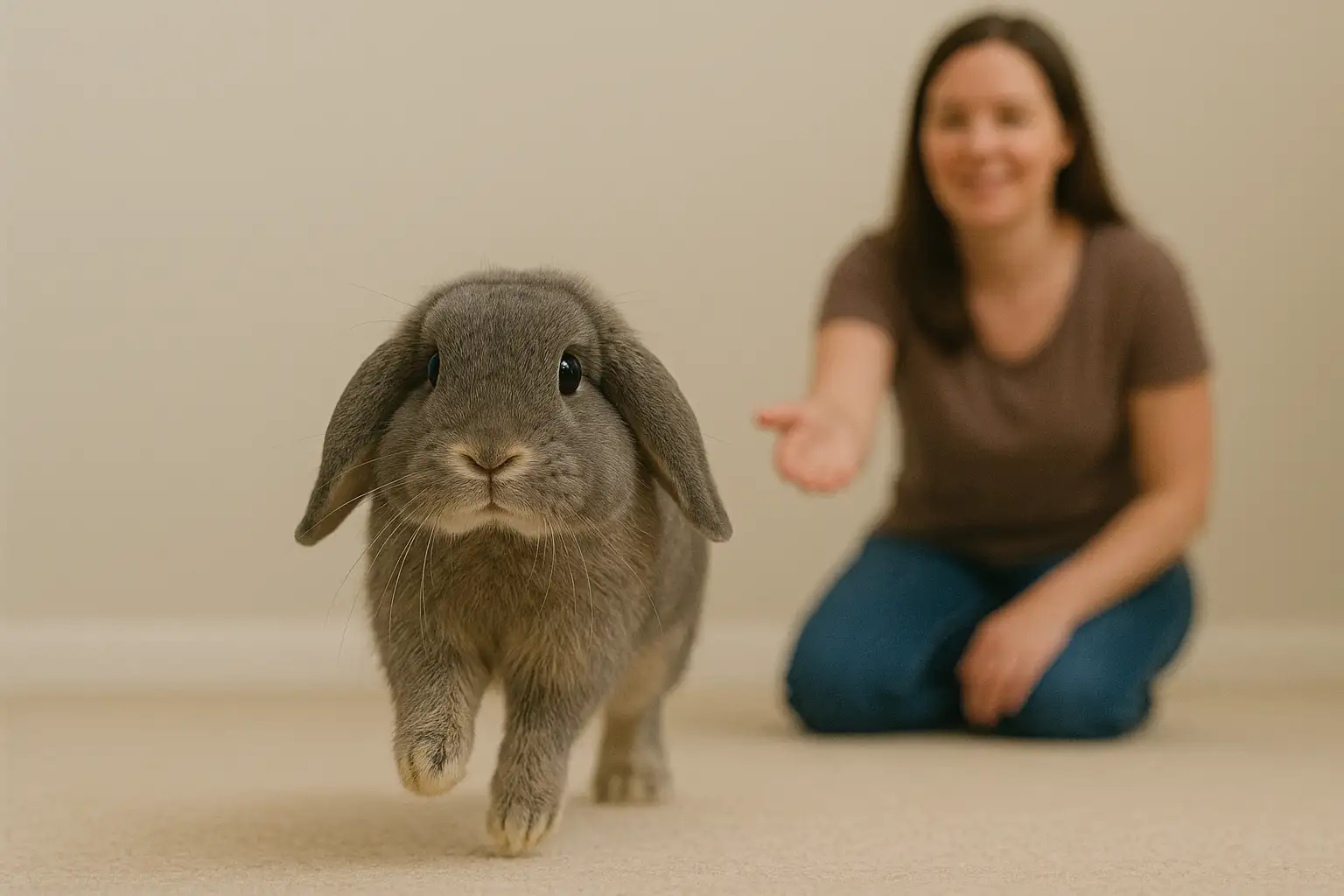
Preparing for Training
Setting up the right conditions before you begin how to train a bunny rabbit to come when called significantly increases your chances of success.
Choosing the Right Environment for Training
The environment plays a crucial role in how effectively you can train your bunny to come when called. Start in a small, enclosed space where your rabbit feels safe and comfortable. This could be a hallway, bathroom, or small bedroom—anywhere your bunny is familiar with and has limited hiding spots.
I made the mistake of trying to train Clover in our open living room initially, and she was too distracted by all the furniture to hide under. When I switched to our narrow hallway, she could focus much better on learning to come when called.
Make sure the training area is:
- Free from loud noises or sudden movements
- Protected from other pets
- Temperature-controlled (rabbits are sensitive to extreme heat)
- Carpeted or with a non-slip surface for easy hopping
- Free of dangerous cords or items your bunny might chew
As your bunny becomes more proficient at coming when called, you can gradually increase the size of the training area until you’re working in larger spaces.
Essential Training Supplies for Calling Your Bunny
To effectively train your bunny to come when called, gather these supplies before starting:
Treats: Choose healthy, small treats that your bunny loves. Fresh herbs like basil, cilantro, or small pieces of carrot work well. I discovered Clover would do almost anything for a tiny slice of banana, so that became our special training treat.
Clicker (optional): A small device that makes a distinct clicking sound to mark correct behavior.
Target stick (optional): A thin stick with a ball on the end that helps guide your bunny.
Consistent verbal cue: Decide on a specific word or phrase like your bunny’s name followed by “come” and use it consistently.
Long, low-stress sessions: Set aside time when both you and your bunny are relaxed.
Patience: Perhaps the most important supply of all!
Keep treats in a separate container used only for training, so your bunny begins to associate that container with the positive experience of learning to come when called.

Timing and Duration of Training Sessions
When training your bunny to come when called, timing is everything. Short, frequent sessions are far more effective than long, infrequent ones. Aim for:
- 3-5 minute sessions
- 2-3 times per day
- Just before regular feeding times when your bunny is motivated but not starving
- When your bunny is naturally active (typically dawn and dusk for most rabbits)
I noticed Clover was most responsive to training to come when called in the early evening when she was naturally more active. Morning sessions were less effective because she was more interested in her breakfast than in training.
Pay attention to your bunny’s body language during training. If they seem disinterested or stressed, end the session on a positive note and try again later. Consistency matters more than duration when teaching your bunny to come when called.
Training Techniques
Now that you understand your bunny’s behavior and have prepared the environment, it’s time to implement effective techniques on how to train a bunny rabbit to come when called.
Using Positive Reinforcement for Training Bunnies
Positive reinforcement is the cornerstone of successfully learning how to train your bunny to come when called. This approach rewards behaviors you want to see more of, making your bunny eager to repeat those actions.
When I started training Clover, I quickly learned that praise and petting weren’t enough—she needed tangible rewards to understand that coming when called was worth her effort. Here’s how to effectively use positive reinforcement:
- Immediate rewards: Give the treat within 1-2 seconds of your bunny coming to you
- Consistency: Always reward the desired behavior during the learning phase
- Appropriate treats: Use small, healthy treats that your bunny finds irresistible
- Enthusiastic praise: Combine treats with a happy, encouraging tone
- Never punish: Negative reinforcement will damage trust and set back your training
Remember that rabbits respond to your energy, so maintain a positive, patient attitude throughout the training process. If you get frustrated, your bunny will sense it and may become anxious about training.
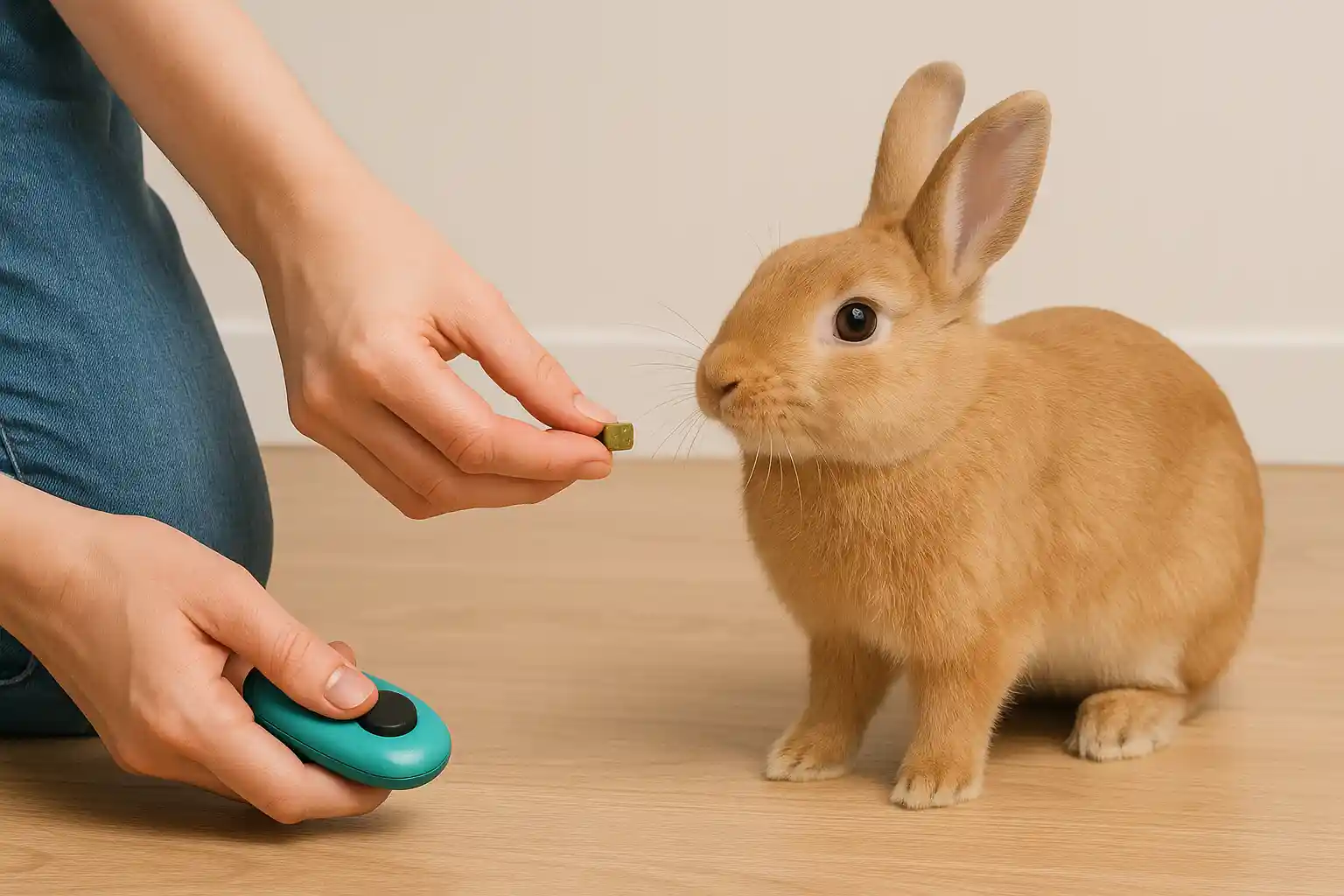
Clicker Training for Bunnies: A Step-by-Step Guide
Clicker training is particularly effective when teaching your bunny to come when called because it precisely marks the exact moment your bunny performs the correct behavior.
Here’s how to implement clicker training with your bunny:
- Charging the clicker: Begin by clicking and immediately giving a treat several times, so your bunny associates the click with rewards.
- Adding distance: Once your bunny understands the click means treats, move a short distance away and call their name followed by “come.”
- Capturing the behavior: The moment your bunny moves toward you, click and offer a treat.
- Building consistency: Gradually increase the distance, always clicking the moment your bunny starts moving toward you when called.
- Adding the verbal cue: Eventually, your bunny will respond to the verbal cue alone as they learn to come when called.
When I introduced the clicker with Clover, she understood the association within just one training session. The distinct sound of the click helped her identify exactly what behavior earned her the treat—moving toward me when I called her name.
Incorporating Treats to Encourage Your Bunny
Treats are powerful motivators when training your bunny to come when called, but they must be used strategically:
Finding the right treat: I tested several options before discovering that small banana slices were Clover’s ultimate motivation for coming when called. Experiment with different healthy treats to find your bunny’s favorite.
Treat size matters: Keep training treats tiny—about the size of your bunny’s thumbnail. This prevents overfeeding while allowing multiple repetitions during training.
Treat delivery: Hold the treat at your bunny’s nose level when they reach you, making it easy for them to receive their reward for coming when called.
Treat fading: As your bunny becomes more consistent, gradually reduce how often you give treats. Eventually, offer treats only occasionally while still providing praise every time.
Healthy options: Stick to bunny-safe treats like tiny pieces of:
- Banana
- Apple (no seeds)
- Carrot
- Herbs (cilantro, basil, mint)
- Small pieces of dried fruit (occasionally)
Using a variety of treats keeps training interesting for your bunny. I rotate through Clover’s favorites to maintain her enthusiasm for coming when called during our training sessions.
Troubleshooting Training Challenges
Even with proper preparation and technique, you may encounter challenges when learning how do you house train a bunny to come when called. Here’s how to address common issues.
What to Do if Your Bunny Doesn’t Respond
If your bunny isn’t responding to your call, don’t get discouraged. There are several potential reasons and solutions:
Reassess your training environment: My first breakthrough with Clover happened when I realized our training space was too distracting. Moving to a quieter, smaller room immediately improved her response to coming when called.
Check your timing: Ensure you’re training when your bunny is naturally active, not during their rest periods.
Evaluate your treats: Your bunny might not find the current treats motivating enough. Try something more enticing.
Shorten the distance: You may be asking your bunny to come from too far away initially. Start with just a couple of feet between you.
Health concerns: If your previously responsive bunny suddenly stops coming when called, consider a vet check-up, as health issues can affect training performance.
Build more trust: Sometimes the foundation of trust needs more work before training can progress. Spend more time bonding with your bunny through gentle interaction before resuming training. If you’re working with a new or unfamiliar rabbit, our guide on how to get a stray bunny to come to you offers specialized techniques.
Remember that training your bunny to come when called is a process that requires patience. Some rabbits learn quickly, while others need more time to build confidence.
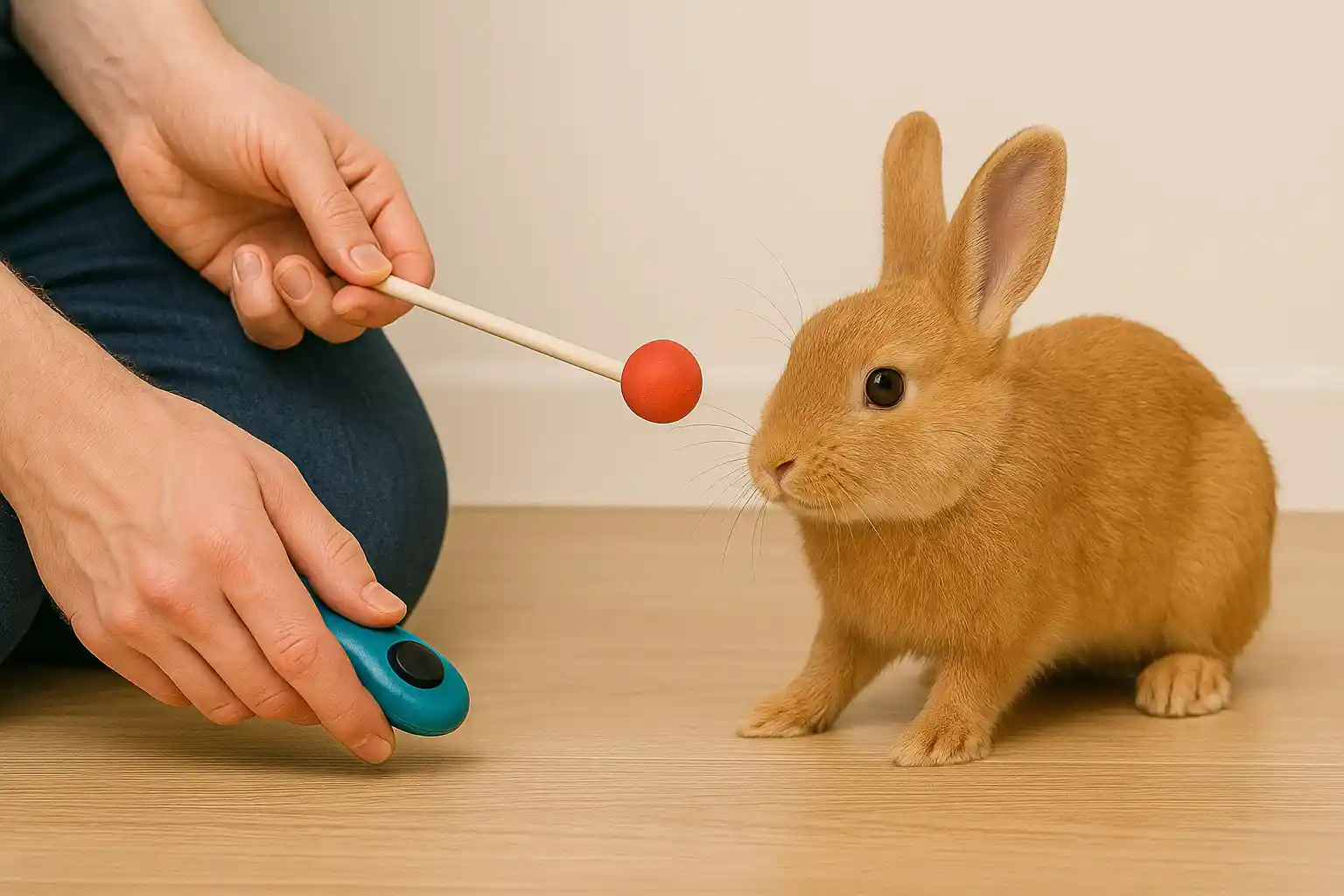
Addressing Fear and Anxiety in Bunnies During Training
Fear and anxiety can significantly impede your efforts to train your bunny to come when called. Signs your bunny might be anxious include:
- Thumping
- Freezing in place
- Running away
- Hiding
- Rapid breathing
If you notice these behaviors, it’s essential to adjust your approach:
- Take a step back: Return to an earlier, successful stage of training where your bunny felt comfortable.
- Lower your voice: Use a soft, gentle tone when calling your bunny. Loud voices can trigger fear responses.
- Get on their level: Sit on the floor rather than standing over your bunny, which can feel threatening.
- Create positive associations: Spend time near your bunny without any training expectations, just offering treats and gentle pets if welcomed. Our guide on how to make a bunny trust you provides more detailed techniques for building this crucial foundation.
- Consider environmental factors: Check for potential stressors like loud noises, strong smells, or the presence of predator animals (even through windows).
When Clover showed signs of anxiety during our training sessions, I discovered that my neighbor’s dog barking was coinciding with our practice times. Changing our schedule resolved the issue, and she became much more responsive to coming when called.
Common Mistakes to Avoid When Training Your Bunny
Through my own trial and error in training Clover to come when called, I’ve identified several common mistakes to avoid:
Inconsistent cues: Using different words or tones each time confuses your bunny. Stick with one clear phrase.
Punishment: Never scold or punish your bunny for not coming. This creates negative associations with you and with training.
Grabbing when they approach: If you immediately pick up your bunny every time they come to you, they’ll learn that coming when called leads to being restrained—something most rabbits dislike.
Training when distracted: If you’re not fully engaged, your bunny won’t be either. Choose times when you can focus completely on the training session.
Sessions that are too long: Bunnies have short attention spans. Five minutes of focused training is better than 20 minutes of diminishing returns.
Moving too quickly: Rushing through training stages before your bunny is ready sets both of you up for frustration.
By avoiding these common pitfalls, you’ll create a positive training experience that makes your bunny more likely to reliably come when called.
Maintaining Training Consistency
Once your bunny begins to respond to your call, maintaining and strengthening that behavior becomes your focus when continuing how to train a bunny rabbit to come when called.
Developing a Routine for Consistent Training
Consistency is crucial when learning how to train your bunny to come when called. Establishing a routine helps your rabbit understand expectations and builds reliable responses.
I found that creating a training schedule with Clover dramatically improved her performance. Here’s how to develop an effective training routine:
- Set specific training times: Train at the same times each day when possible. Rabbits thrive on routine and will begin to anticipate and prepare for training sessions.
- Create a pre-training ritual: I always shake Clover’s treat container before our sessions, which serves as a cue that training to come when called is about to begin.
- Use the same location initially: Consistency in environment helps your bunny focus on learning the command rather than adjusting to new surroundings.
- Keep commands identical: Use the exact same words and tone each time you call your bunny.
- Track progress: Keep a simple log of training sessions, noting improvements or challenges in your bunny’s response to coming when called.
- Gradual environmental changes: Once your bunny consistently comes when called in one location, slowly introduce new environments while maintaining all other aspects of your routine.
After establishing our routine, Clover began to show visible excitement when she heard the treat container—her ears would perk up and she’d hop closer, ready to practice coming when called.
Keeping Training Sessions Engaging for Your Bunny
Preventing boredom is essential for successful long-term training. Here are strategies to keep your bunny engaged in learning to come when called:
Vary your position: Call your bunny from different positions in the room—sitting, kneeling, or standing in different spots.
Change directions: Have your bunny come to you from different starting points.
Incorporate obstacles: Once basics are mastered, add simple obstacles for your bunny to navigate around when coming to you.
Mix in other activities: Alternate between training to come when called and other enjoyable activities like gentle petting or play.
New environments: Gradually practice in different rooms or areas to generalize the skill.
I discovered that Clover remained most engaged when I unpredictably changed my position between calls, creating a game-like atmosphere that kept her interested in coming when called.
Evaluating Progress in Your Bunny’s Training
Regularly assessing your bunny’s progress helps you adjust your training approach and celebrate achievements in teaching them to come when called.
Look for these signs of progress:
- Quicker response times: Your bunny starts moving toward you faster when called
- Greater distances: Successfully coming from increasingly farther starting points
- Overcoming distractions: Responding even with mild distractions present
- Enthusiasm: Showing excitement when hearing the command
- Reliability: Consistent response rate of 80% or higher
These improvements are also excellent signs your bunny trusts you, indicating your relationship is growing stronger through this training process.
When evaluating Clover’s progress, I noticed she mastered coming when called in our hallway after about two weeks of consistent training. However, when we moved to the living room, her success rate initially dropped to about 60%. This helped me recognize that we needed more practice with environmental transitions.
If progress stalls, don’t be discouraged. Sometimes taking a step back to an earlier, successful stage of training your bunny to come when called can help rebuild confidence before moving forward again.
Alternative Training Tips and Strategies
Beyond the fundamental techniques, several alternative approaches can enhance your success in how do you house train a bunny to come when called.
Using Visual Cues in Bunny Training
While verbal cues are important, rabbits are highly visual creatures. Incorporating visual signals can significantly improve your bunny’s understanding of the come command.
Effective visual cues include:
- Hand signals: I pair Clover’s verbal command with a beckoning motion of my hand, which she now responds to even when she can’t hear me clearly.
- Consistent posture: Adopting the same body position (such as kneeling) when calling your bunny provides a clear visual indicator.
- Target training: Using a target stick gives your bunny something specific to approach, making the concept of coming when called more concrete.
- Path lighting: For hesitant bunnies, creating a well-lit path between you and them can increase confidence in approaching.
- Color association: Wearing a specific color during training sessions can help your bunny recognize training time.
I noticed that Clover actually responded better to the combination of verbal and visual cues than to either one alone. When I call her while also using the hand signal, her response to coming when called is nearly immediate.
The Role of Socialization in Training Your Bunny
Well-socialized rabbits typically learn commands like coming when called more readily than those with limited human interaction. Here’s how socialization impacts training:
Trust foundation: Socialized bunnies trust humans and are more willing to approach when called.
Reduced fear responses: Regular, positive interactions reduce stress during training sessions.
Increased engagement: Socialized rabbits are generally more curious and attentive during training.
To enhance socialization while training your bunny to come when called:
- Daily handling: Spend time gently petting and handling your bunny outside of training sessions.
- Multiple trainers: Once your bunny responds consistently to you, have family members or friends (using identical commands) call your bunny.
- Positive visitor experiences: Allow visitors to offer treats when your bunny approaches them.
When my niece started participating in Clover’s training, I noticed an interesting development—Clover began generalizing the “come” command to other humans, making her more responsive to everyone in the household.
Group Training: Can Bunnies Learn from Each Other?
The concept of bunnies learning from watching other rabbits is fascinating and potentially useful. While research on rabbit observational learning is limited, many owners (myself included) have noticed apparent learning transfer between rabbits.
If you have multiple bunnies, you might observe:
- Modeling behavior: Less confident rabbits may follow the lead of more confident ones when responding to calls.
- Competitive motivation: Some bunnies become more motivated to come when called if they see another rabbit receiving treats for the same behavior.
- Combined training: Training bunnies together can sometimes accelerate learning through social facilitation.
However, there are important considerations for group training:
- Individual sessions first: Establish basic coming when called with each bunny separately before attempting group training.
- Prevent resource guarding: Ensure each bunny receives their own treats to avoid competition or intimidation.
- Watch for social dynamics: If one bunny is dominant, the other might be too intimidated to approach when both are called.
When I introduced a second rabbit, Sage, to our household, I was surprised to see how quickly she picked up on coming when called after watching Clover respond and receive treats. Within just a few days, both bunnies would hop over when called—though I still made sure to reward them individually. If you’re working with multiple rabbits, check out our guide on how to get a rabbit to come to you for more specialized techniques.
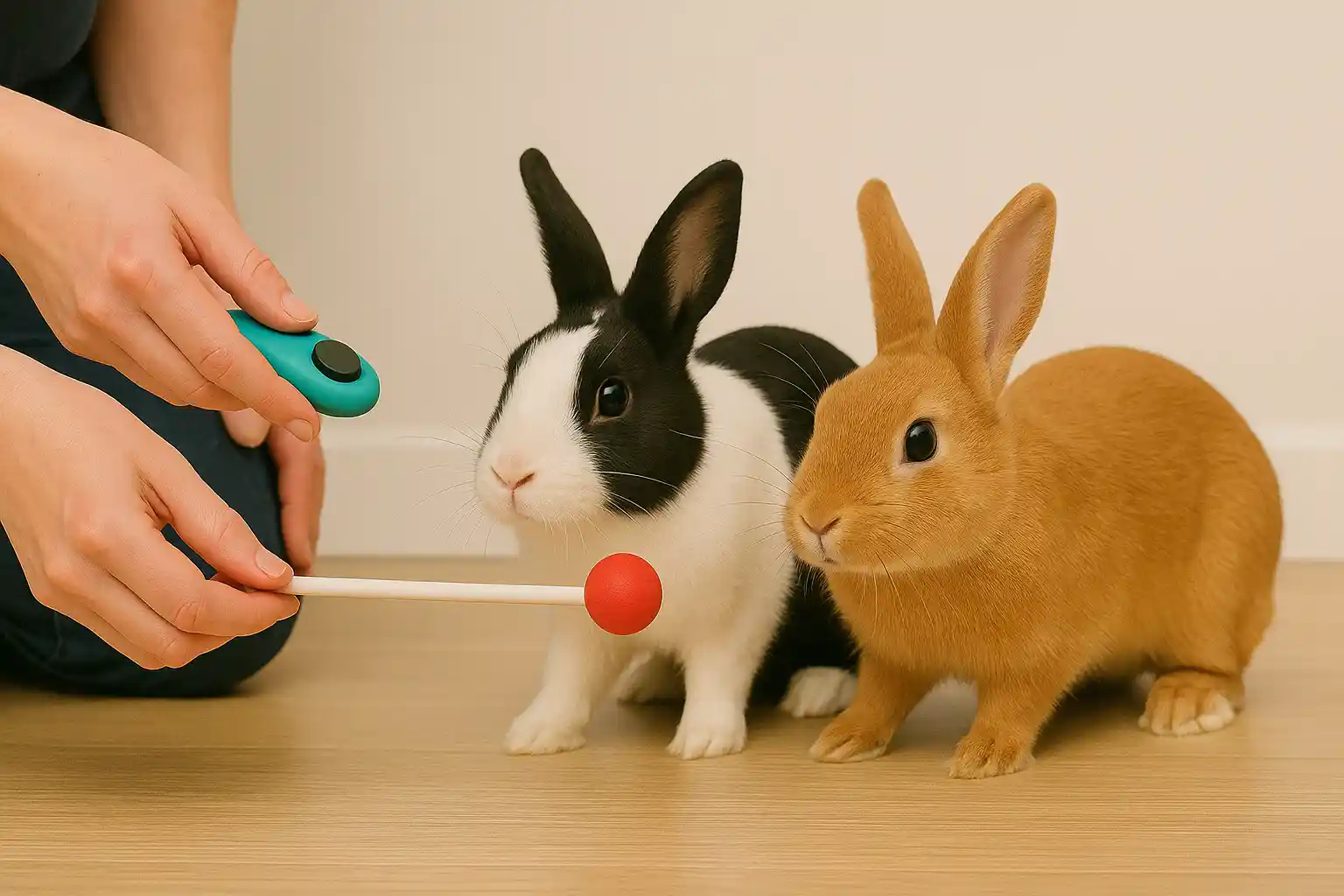
Conclusion
How to train your bunny to come when called is a rewarding journey that strengthens your bond while providing practical benefits. Through understanding bunny behavior, proper preparation, consistent training techniques, troubleshooting challenges, and maintaining consistency, you can successfully teach this valuable skill to your rabbit companion.
Remember that every bunny learns at their own pace. What took Clover three weeks might take your rabbit longer or shorter depending on their unique personality and background. The key is patience, consistency, and making the process of how to train a bunny rabbit to come when called enjoyable for both of you.
Beyond the practical applications, the process of training your bunny to come when called creates a special language between you and your pet. That moment when your bunny hops to you enthusiastically upon hearing your call represents a beautiful bridge of communication and trust—something every rabbit owner should experience.
So shake that treat container, call your bunny’s name with enthusiasm, and enjoy the journey of how to train a bunny rabbit to come when called. The results are well worth the effort.
Frequently Asked Questions
How do I train my rabbit to come when called?
To train your rabbit to come when called, start in a quiet, small space using consistent verbal cues paired with favorite treats. Begin by associating your call with immediate rewards, then gradually increase distance. Practice 3-5 minute sessions daily, rewarding instantly when your bunny approaches. How to train your bunny to come when called requires patience and consistent positive reinforcement.
How do I make my rabbit come to me?
To make your rabbit come to you, establish a positive association with your presence by offering favorite treats and using consistent verbal cues. Start close to your bunny, call their name followed by “come,” and reward immediately when they approach. Mastering how to train your bunny to come when called means never chasing or forcing your bunny, as this damages trust.
How to get a stray bunny to come to you?
To get a stray bunny to come to you, move slowly and sit quietly at their level. Offer appealing food like leafy greens or carrots placed near you, avoiding sudden movements or loud noises. Unlike the structured approach of how to train your bunny to come when called with pet rabbits, with strays you must be patient and allow the bunny to approach at their own pace.
Will rabbits respond to their name?
Yes, rabbits will respond to their name when trained consistently. Bunnies can learn to recognize specific sounds, including their name, through positive reinforcement. When learning how do you house train a bunny to come when called, always pair their name with treats and affection. Most rabbits will eventually perk up their ears or hop toward you when called by name.
What treats work best when training your bunny to come when called?
Small pieces of fresh herbs, tiny banana slices, and small apple pieces typically work best when training your bunny to come when called. The ideal treat is something your individual rabbit finds irresistible but is still healthy in small quantities. Most rabbits respond well to bits of their favorite leafy greens when learning how to come when called.

